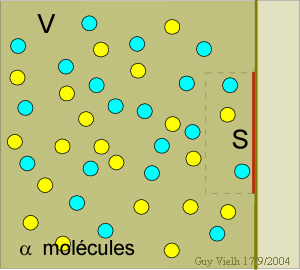Understanding the law of perfect gases through the mechanics of molecules
PDF
By multiplying by the amount of movement 2 m u provided by each molecule and dividing by the surface area, we obtain the pressure p = (N/V) mu2.
The speed u of each molecule depends on the chance of the shocks it undergoes. The pressure results from the average of u2 on all molecules, noted < u2>. The previous formula therefore gives pV = Nm<u2>. Comparison with the law of perfect gases thus makes it possible to link the kinetic energy of the molecules (1/2)m<u2> to the temperature by (1/2)m<u2> = (1/2)kBT.
The molecules actually move with a velocity vector u in all directions, and according to Pythagoras’ theorem, u2 = u2+v2+w2+w2, where u, v, w are the velocity projections according to each coordinate. These are identical on average in all directions, < u2>=< u2>+< v2>+< v2>+< w2>=3<u2>, which allows the total kinetic energy of translation of molecules to be expressed as ,1/2)m< u2> = (3/2)kBT.
The shocks on the wall are not elastic as we have assumed here: molecules exchange energy with the atoms in the wall. However, at thermal equilibrium, there is no net energy exchange between the gas and the wall, which validates the hypothesis of an elastic shock on average. Similarly, molecules do not exchange an average amount of movement tangentially to the wall, as their velocity along the wall is zero on average. So there is no tangential force. This would no longer be the case if there was a flow along the wall with a tangential viscosity force.




